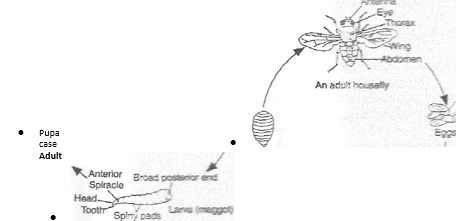Growth of Animals
- In higher animals, most cells with the exception of the nerve cells, retain their power of division.
- Thus, there is a continued breakdown and replacement of cells.
- Animal cells undergo rapid cell division and cell differentiation but, unlike plant cells, they undergo very little cell enlargement.
- In most animals growth occurs through their life till they die.
- This type of growth called continuous growth.
- Arthropods e.g. insects show rapid growth immediately after moulting with periods when no growth increase occurs.
- This is called discontinuous growth.
- Insects exhibit two types of reproduction processes.
- In some insects, the ova in the female are fertilised by the spermatozoa from the male.
- This is a typical example of sexual reproduction, common in butterflies and moths.
- In other insects like the black and green aphids, the eggs are usually product without being fertilised and are able to turn into adult insects.
- This type of asexual reproduction is referred to parthenogenesis.
Growth and Development in Insects
- Majority of insects lay eggs that hatch into larvae, which is an immature stage, usually quite different from the adults in morphology and behaviour.
- Depending on the insect species a larva is referred to as a grub, maggot or a caterpillar.
- Generally the larvae eats a lot, grows rapidly and sheds its cuticle several times until it reaches full size to become a pupa.
- The pupa is an inactive, non feeding stage during which extensively breakdown and re-organisation of body tissue occur, eventually giving rise to the imago or adult form.
- Such changes, called metamorphosis, do occur in butterflies moths, bees, wasps and flies.
- Insects which pass through these stages, namely, egg-larva-pupa, into imago/adult in their development are said to undergo complete metamorphosis.
Complete Metamorphosis in Insects
- Consider the development in a housefly- When the egg of a housefly is laid, it measures about 1mm in length.
- The eggs are laid in batches of between 100 to 150.
- The larvae which hatch from the eggs grow and feed on decaying matter.
- After several moults and increase in size, a Jarva reaches about 1cm in length.
- This takes about 5 days.
- After this, the larva changes into a pupa encased in a pupal case called die puparium, from which the adult fly later emerges.
- After emergence, the adult takes about two weeks of feeding and growing to attain sexual maturity, i.e. the males can mate and the females are able to lay eggs.
- Figure 4.14 summarises the life cycle of a housefly.
Incomplete Metamorphosis in Insects
- Development in some insects like the locust and cockroaches, involves the egg hatching into a nymph which resembles the adult in every form, except for size and lack of sexual maturity.
- Pupa case Adult pushes out against the case.
- For such insects to reach the adult, stages, they undergo a series of moults before fully acquiring the adult size and attaining the sexual maturity.
- These insects are said to undergo incomplete metamorphosis.

- Consider the development in a Cockroach
- Cockroaches produce eggs enclosed in a case in groups of between 10 - 15.
- The case known as ootheca and contains many eggs.
- The ootheca is usually deposited in moist dark and warm places, for example in cracks of furniture or crevices in walls.
- It takes about a month before the small wingless nymphs emerge.
- The nymphs feed, and moult about ten times with the total nymphal period lasting about 16 days for all the adult structure to become fully developed.
Role of Hormones in Insect Metamorphosis
- In insects metamorphosis is controlled by hormones.- The hormones are produced in three glands namely;
- Neurosecretory cells in the brain ganglia, a pair of corpora allata (singular Corpus allatum) located in the mandibular segment and prothoracic glands in the thorax.
- During larval stages of the insect the corpora ailata produces juvenile hormone.
- This leads to formation of larval cuticle., therefore moulting does not go beyond the larval stage.
- When the larva matures, the corpus allatum disintegrates.
- At this time the neurosecretory cells stimulate the prothoracic glands to produce moulting hormone (ecdysone).
- Ecdysone is responsible for moulting in insects leading to the laying of the adult cuticle.
